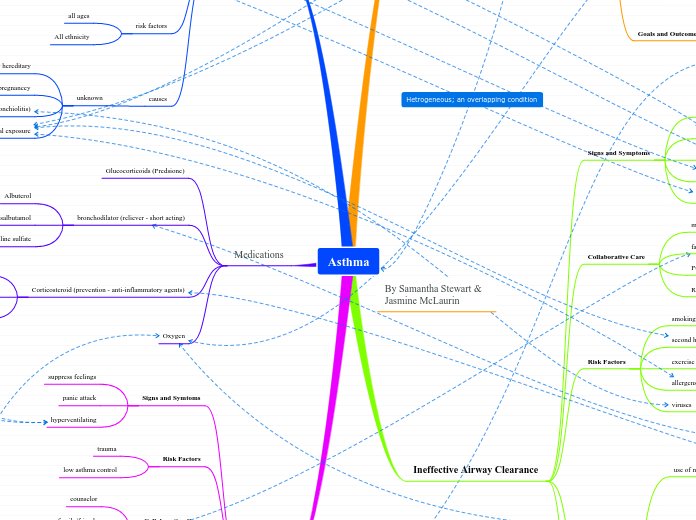Asthma
COPD (Inflammatory disease that effects the small airways)
Signs and Symptoms
cough
phlegm
wheezing
Risk Factors
smoking
air pollution
occupational exposure
Age >45 years old
Collaborative care
Respiratory
physical therapy - depending on severity
Interventions
Oxygen therapy
smoking cessation
cluster care
medications
Goals and Outcomes
maintain O2 stats above 94%
quit smoking
maintain ADLs
taking medications properly
Ineffective Airway Clearance
Signs and Symptoms
low O2
wheezing
breathlessness
chest tightening
coughing
Collaborative Care
mental health
family/friend
Pulmonology
Respiratory
Risk Factors
smoking
second hand smoke
exercise
allergens
viruses
Interventions
use of medication
bronchodilator
corticosteriods
antibiotic medications
severe cases - oxygen therapy
control
step up or step down method
know your environment triggers
nutrition
healthy lifestyle
teaching of effective way of using inhaler
spacers
dry powder
meter dose
peak flow meter
Incentive spirometry
Goals and Outcomes
control of inflammation
no limitations of activities
minimal side effects of medications
not waking from coughing
normal lung function
taking medications properly
Pathophysiology
Inflammatory respiratory disease
Effects small and large airways
airway obstuction of smooth muscle
mucus clog airways
broncho-constriction
signs and symptom
wheezing
breathlessness
chest tighteneing
coughing
Late-phase
eosinophils make the airway becomes oedematous, the bronchial wall becomes constricted and the airway is compromised by overproduction of mucus
risk factors
all ages
All ethnicity
causes
unknown
possibly hereditary
smoking during pregnancey
child hood infection (Bronchiolitis)
environmental exposure
Medications
Glucocorticoids (Predsione)
bronchodilator (reliever - short acting)
Albuterol
salbutamol
terbutaline sulfate
Corticosteroid (prevention - anti-inflammatory agents)
Flovent
beclometason dipropionate
budesonide
Oxygen
Anxiety
Signs and Symtoms
suppress feelings
panic attack
hyperventilating
Risk Factors
trauma
low asthma control
Collaborative Care
counselor
family/friends
teachers
Interventions
treat psychological
assess the patient ability to process emotions
deep breathing
medications
teaching of medication and importance
re-breather (or paper bag)
Goals and outcomes
communication emotions/fears properly
having control of asthma (proper management)
